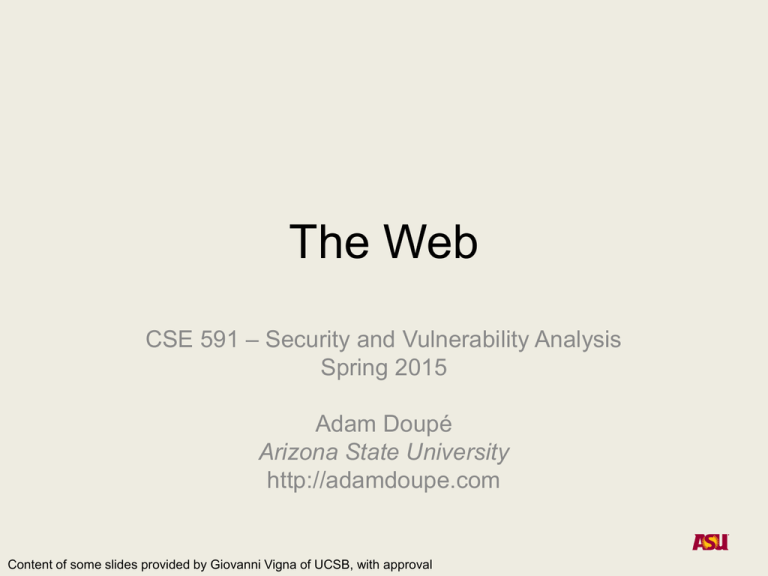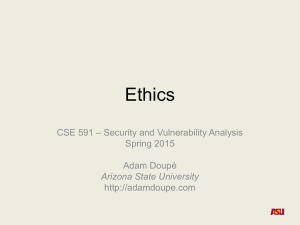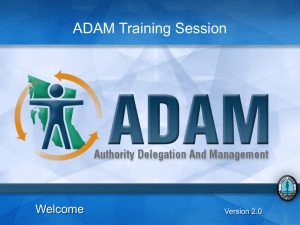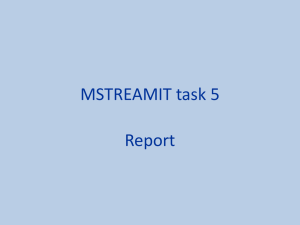The Web - Adam Doupé
advertisement

The Web CSE 591 – Security and Vulnerability Analysis Spring 2015 Adam Doupé Arizona State University http://adamdoupe.com Content of some slides provided by Giovanni Vigna of UCSB, with approval Adam Doupé, Security and Vulnerability Analysis Adam Doupé, Security and Vulnerability Analysis Sir Tim Berners-Lee Adam Doupé, Security and Vulnerability Analysis Birth of the Web • Created by Tim Berners-Lee while he was working at CERN – First CERN proposal in 1989 – Finished first website end of 1990 • Weaving the Web: The Original Design and Ultimate Destiny of the World Wide Web, Tim Berners-Lee Adam Doupé, Security and Vulnerability Analysis Design • Originally envisioned as a way to share research results and information at CERN • Combined multiple emerging technologies – Hypertext – Internet (TCP/IP) • Idea grew into “universal access to a large universe of documents” Adam Doupé, Security and Vulnerability Analysis Three Central Questions • How to name a resource? • How to request and serve a resource? • How to create hypertext? Adam Doupé, Security and Vulnerability Analysis Three Central Technologies • How to name a resource? – Uniform Resource Identifier (URI/URL) • How to request and serve a resource? – Hypertext Transfer Protocol (HTTP) • How to create hypertext? – Hypertext Markup Language (HTML) Adam Doupé, Security and Vulnerability Analysis HTML HTTP Adam Doupé, Security and Vulnerability Analysis URI Uniform Resource Identifier • Essential meta-data to reach/find a resource • Answers the following questions: – Which server has it? – How do I ask? – How can the server locate the resource? • Latest definition in RFC 3986 (January 2005) Adam Doupé, Security and Vulnerability Analysis URI – Syntax <scheme>:<authority>/<path>?<query>#<fragment> Adam Doupé, Security and Vulnerability Analysis URI – Syntax <scheme>:<authority>/<path>?<query>#<fragment> • scheme – The protocol to use to request the resource • authority – The entity that controls the interpretation of the rest of the URI – Usually a server name • <username>@<host>:<port> • path – Usually a hierarchical pathname composed of “/” separated strings • query – Used to pass non-hierarchical data • fragment – Used to identify a subsection or subresource of the resource Adam Doupé, Security and Vulnerability Analysis URI – Syntax <scheme>:<authority>/<path>?<query>#<fragment> Examples: foo://example.com:8042/over/there?test=bar#nose ftp://ftp.ietf.org/rfc/rfc1808.txt mailto:doupe@asu.edu https://example.com/test/example:1.html?/adam Adam Doupé, Security and Vulnerability Analysis URI – Reserved Characters : / ? # [ ] @ ! $ Adam Doupé, Security and Vulnerability Analysis & ‘ ( ) * + , ; = URI – Percent Encoding • Must be used to encode anything that is not of the following: Alpha [a-zA-Z] Digit [0-9] . _ ~ Adam Doupé, Security and Vulnerability Analysis URI – Percent Encoding • Encode a byte outside the range with percent sign (%) followed by hexadecimal representation of byte – – – – & -> %26 % -> %25 <space> -> %20 … • Let’s fix our previous example: – https://example.com/test/example:1.html?/ad am – https://example.com/test/example%3A1.html?% 2Fadam Adam Doupé, Security and Vulnerability Analysis URI – Absolute vs. Relative • URI can specify the absolute location of the resource – https://example.com/test/help.html • Or the URI can specify a location relative to the current resource – //example.com/example/demo.html • Relative to the current network-path (scheme) – /test/help.html • Relative to the current authority – ../../people.html • Relative to the current authority and path • Context important in all cases – http://localhost:8080/test Adam Doupé, Security and Vulnerability Analysis Hypertext Transport Protocol • Protocol for how a web client can request a resource from a web server • Based on TCP, uses port 80 by default • Version 1.0 – Defined in RFC 1945 (May 1996) • Version 1.1 – Defined in RFC 2616 (June 1999) • Version 2.0 – Based on SPDY, still under discussion Adam Doupé, Security and Vulnerability Analysis HTTP – Important Terms • user agent – The client which initiates the request • server – A program which accepts HTTP requests and sends HTTP responses • proxy – An intermediary which acts as both a server and client for the purpose of making requests on behalf of other clients Adam Doupé, Security and Vulnerability Analysis HTTP – Overview • Client – Opens TCP connection to the server – Sends request to the server • Server – Listens for incoming TCP connections – Reads request – Sends response Adam Doupé, Security and Vulnerability Analysis HTTP – Overview HTTP Request HTTP Response Client Adam Doupé, Security and Vulnerability Analysis Server HTTP – Overview Cache Server Client Cache Firewall Adam Doupé, Security and Vulnerability Analysis Proxy Requests • An HTTP request consists of: – method – resource (derived from the URI) – protocol version – client information – body (optional) Adam Doupé, Security and Vulnerability Analysis Requests – Syntax • Start line, followed by headers, followed by body – Each line separated by CRLF • Headers separated by body via empty line (just CRLF) Adam Doupé, Security and Vulnerability Analysis Requests – Methods • The method that that client wants applied to the resource • Common methods • GET – Request transfer of the entity referred to by the URI • POST – Ask the server to process the included body as “data” associated with the resource identified by the URI • PUT – Request that the enclosed entity be stored under the supplied URI • HEAD – Identical to GET except server must not return a body Adam Doupé, Security and Vulnerability Analysis Requests – Methods • OPTIONS – Request information about the communication options available on the request/response chain identified by the URL • DELETE – Request that the server delete the resource identified by the URI • TRACE – used to invoke a remote, applicationlayer loop-back of the request message and the server should reflect the message received back to the client as the body of the response • CONNECT – used with proxies • … – A webserver can define arbitrary extension methods Adam Doupé, Security and Vulnerability Analysis Requests – Example GET / HTTP/1.1 User-Agent: curl/7.37.1 Host: www.google.com Accept: */* Adam Doupé, Security and Vulnerability Analysis Host Header and HTTP/1.1 • In HTTP 1.0, it is not possible to discern, from the request line, which server was intended to process the request: GET / HTTP/1.0 • Thus, it is not possible to associate multiple server names to the same IP address – What would happen if every server name had to have its own IP address? • In HTTP 1.1, the “Host” header is required, and it specifies which server name is the intended recipient GET / HTTP/1.1 Host: example.com Adam Doupé, Security and Vulnerability Analysis Modern Requests GET / HTTP/1.1 Host: www.google.com Accept-Encoding: deflate, gzip Accept: text/html,application/xhtml+xml,applic ation/xml;q=0.9,image/webp,*/*;q=0.8 User-Agent: Mozilla/5.0 (Macintosh; Intel Mac OS X 10_10_1) AppleWebKit/537.36 (KHTML, like Gecko) Chrome/39.0.2171.95 Safari/537.36 Adam Doupé, Security and Vulnerability Analysis Responses • An HTTP response consists of: – protocol version – status code – short reason – headers – body Adam Doupé, Security and Vulnerability Analysis Responses – Syntax • Status line, followed by headers, followed by body – Each line separated by CRLF • Headers separated by body via empty line (just CRLF) • Almost the same overall structure as request Adam Doupé, Security and Vulnerability Analysis Responses – Status Codes • 1XX – Informational: request received, continuing to process • 2XX – Successful: request received, understood, and accepted • 3XX – Redirection: user agent needs to take further action to fulfill the request • 4XX – Client error: request cannot be fulfilled or error in request • 5XX – Server error: the server is aware that it has erred or is incapable of performing the request Adam Doupé, Security and Vulnerability Analysis Responses – Status Codes • • • • • • "200" "201" "202" "204" “301" "307" ; ; ; ; ; ; OK Created Accepted No Content Moved Permanently Temporary Redirect Adam Doupé, Security and Vulnerability Analysis Responses – Status Codes • • • • • • • • "400" "401" "403" "404" "500" "501" "502" "503" ; ; ; ; ; ; ; ; Bad Request Unauthorized Forbidden Not Found Internal Server Error Not Implemented Bad Gateway Service Unavailable Adam Doupé, Security and Vulnerability Analysis Requests – Example GET / HTTP/1.1 User-Agent: curl/7.37.1 Host: www.google.com Accept: */* Adam Doupé, Security and Vulnerability Analysis Responses – Example HTTP/1.1 200 OK Date: Tue, 13 Jan 2015 03:57:26 GMT Expires: -1 Cache-Control: private, max-age=0 Content-Type: text/html; charset=ISO-8859-1 Set-Cookie: … Server: gws X-XSS-Protection: 1; mode=block X-Frame-Options: SAMEORIGIN Alternate-Protocol: 80:quic,p=0.02 Accept-Ranges: none Vary: Accept-Encoding Transfer-Encoding: chunked <!doctype html><html itemscope="" itemtype="http://schema.org/WebPage" lang="en"><head><meta content="Search the world's information, including webpages, images, videos and more. Go … Adam Doupé, Security and Vulnerability Analysis HTTP Authentication • Based on a simple challenge-response scheme • The challenge is returned by the server as part of a 401 (unauthorized) reply message and specifies the authentication schema to be used • An authentication request refers to a realm, that is, a set of resources on the server • The client must include an Authorization header field with the required (valid) credentials Adam Doupé, Security and Vulnerability Analysis HTTP Basic Authentication • The server replies to an unauthorized request with a 401 message containing the header field WWW-Authenticate: Basic realm="ReservedDocs" • The client retries the access including in the header a field containing a cookie composed of base64 encoded (RFC 2045) username and password Authorization: Basic QWxhZGRpbjpvcGVuIHNlc2FtZQ== • Can you crack the username/password? Adam Doupé, Security and Vulnerability Analysis HTTP 1.1 Authentication • Defines an additional authentication scheme based on cryptographic digests (RFC 2617) – Server sends a nonce as challenge – Client sends request with digest of the username, the password, the given nonce value, the HTTP method, and the requested URL • To authenticate the users the web server has to have access to clear-text user passwords Adam Doupé, Security and Vulnerability Analysis Monitoring and Modifying HTTP Traffic • HTTP traffic can be analyzed in different ways – Sniffers can be used to collect traffic – Servers can be configured to create extensive logs – Browsers can be used to analyze the content received from a server – Client-side/server-side proxies can be used to analyze the traffic without having to modify the target environment • Client-side proxies are especially effective in performing vulnerability analysis because they allow one to examine and modify each request and reply – Firefox extensions: LiveHTTPHeaders, Tamper Data – Burp Proxy • This is a professional-grade tool that I use Adam Doupé, Security and Vulnerability Analysis Hypertext Markup Language • • • A simple data format used to create hypertext documents that are portable from one platform to another Based on Standard Generalized Markup Language (SGML) (ISO 8879:1986) HTML 2.0 – Proposed in RFC 1866 (November 1995) • HTML 3.2 – Proposed as World Wide Web Consortium (W3C) recommendation (January 1997) • HTML 4.01 – Proposed as W3C recommendation (December 1999) • XHTML 1.0 – Attempt by W3C to reformulate HTML into Extensible Markup Language (XML) (January 2000) • HTML 5.0 – Proposed as W3C recommendation (October 2014) • HTML 5.1 – Under development Adam Doupé, Security and Vulnerability Analysis HTML – Overview • Basic idea is to “markup” document with tags, which add meaning to raw text • Start tag: – <foo> • Followed by text • End tag: – </foo> • Self-closing tag: – <bar /> • Void tags (have no end tag): – <img> Adam Doupé, Security and Vulnerability Analysis HTML – Tags • Tag are hierarchical Adam Doupé, Security and Vulnerability Analysis HTML – Tags <html> <head> <title>Example</title> </head> <body> <p>I am the example text</p> </body> </html> Adam Doupé, Security and Vulnerability Analysis HTML – Tags • <html> – <head> • <title> –Example – <body> • <p> –I am the example text Adam Doupé, Security and Vulnerability Analysis HTML – Tags • Tags can have “attributes” that provide metadata about the tag • Attributes live inside the start tag after the tag name • Four different syntax – <foo bar> • foo is the tag name and bar is an attribute – <foo bar=baz> • The attribute bar has the value baz – <foo bar='baz'> – <foo bar="baz"> • Multiple attributes are separated by spaces – <foo bar='baz' disabled required="true"> Adam Doupé, Security and Vulnerability Analysis HTML – Hyperlink • anchor tag is used to create a hyperlink • href attribute is used provide the URI • Text inside the anchor tag is the text of the hyperlink • <a href="http://google.com">Example</a> Adam Doupé, Security and Vulnerability Analysis HTML – Basic HTML 5 Page <!DOCTYPE html> <html> <head> <meta charset="UTF-8"> <title>CSE 591</title> </head> <body> <a href="http://example.com/">Text</a> </body> </html> Adam Doupé, Security and Vulnerability Analysis HTML – Browsers • User agent is responsible for parsing and interpreting the HTML and displaying it to the user Adam Doupé, Security and Vulnerability Analysis HTML – Parsed HTML 5 Page Adam Doupé, Security and Vulnerability Analysis HTML – Parsed HTML 5 Page Adam Doupé, Security and Vulnerability Analysis HTML – Character References • How to include HTML special characters as text/data? < > ' " & = – Encode the character reference – Also referred to in HTML < 5.0 as “entity reference” or “entity encoding” • Three types, each starts with & and ends with ; – Named character reference • &<predefined_name>; – Decimal numeric character reference • &#<decimal_unicode_code_point>; – Hexadecimal numeric character reference • &#x<hexadecimal_unicode_code_point>; • Note: This will be the root of a significant number of vulnerabilities and is critical to understand Adam Doupé, Security and Vulnerability Analysis HTML – Character References Example • The ampersand (&) is used to start a character reference, so it must be encoded as a character reference • &amp; • &#38; • &#x26; • &#x00026; Adam Doupé, Security and Vulnerability Analysis HTML – Character References Example • • • • é &eacute; &#233; &#xe9; Adam Doupé, Security and Vulnerability Analysis HTML – Character References Example • Why must < be encoded as a character reference? • &lt; • &#60; • &#x30; • &#x00030; Adam Doupé, Security and Vulnerability Analysis HTML – Forms • A form is a component of a Web page that has form controls, such as text fields, buttons, checkboxes, range controls, or color pickers – Form is a way to create a complicated HTTP request • action attribute contains the URI to submit the HTTP request – Default is the current URI • method attribute is the HTTP method to use in the request – GET or POST, default is GET Adam Doupé, Security and Vulnerability Analysis HTML – Forms • Children input tags of the form are transformed into either query URL parameters or HTTP request body • Difference is based on the method attribute – GET passes data in the query – POST passes data in the body • Data is encoded as either “application/x-www-formurlencoded” or “multipart/form-data” – GET always uses “application/x-www-form-urlencoded” – POST depends on enctype attribute of form, default is “application/x-www-form-urlencoded” – "multipart/form-data" is mainly used to upload files, so we will focus on “application/x-www-form-urlencoded” Adam Doupé, Security and Vulnerability Analysis HTML – Forms • Data sent as name-value pairs – Data from the input tags (as well as others) <input type="text" name="foo" value="bar"> • Name is taken from the input tag’s name attribute • Value is taken either from the input tag’s value attribute or the user-supplied input – Empty string if neither is present Adam Doupé, Security and Vulnerability Analysis application/x-www-form-urlencoded • All name-value pairs of the form are encoded • form-urlencoding encodes the name-value pairs using percent encoding – Except that spaces are translated to + instead of %20 • foo=bar • Multiple name-value pairs separated by ampersand (&) Adam Doupé, Security and Vulnerability Analysis application/x-www-form-urlencoded <form action="http://example.com/grades/submit"> <input type="text" name="student" value="bar"> <input type="text" name="class"> <input type="text" name="grade"> <input type="submit" name="submit"> </form> http://example.com/grades/submit?student=Adam+D oupé&class=cse+591&grade=A%2B&submit=Submit Adam Doupé, Security and Vulnerability Analysis application/x-www-form-urlencoded <form action="http://example.com/grades/submit" method="POST"> <input type="text" name="student" value="bar"> <input type="text" name="class"> <input type="text" name="grade"> <input type="submit" name="submit"> </form> POST /grades/submit HTTP/1.1 Host: example.com User-Agent: Mozilla/5.0 (Macintosh; Intel Mac OS X 10.10; rv:34.0) Gecko/20100101 Firefox/34.0 Accept: text/html,application/xhtml+xml,application/xml;q=0.9,*/*;q=0.8 Accept-Language: en-US,en;q=0.5 Accept-Encoding: gzip, deflate Connection: keep-alive Content-Type: application/x-www-form-urlencoded Content-Length: 68 student=Adam+Doup%C3%A9&class=cse+591&grade=A%2B&submit=Submit+Query Adam Doupé, Security and Vulnerability Analysis The Web • URI/URL describes where to locate a document • HTTP describes how to ask for a document • HTML anchors and forms describe how to find more information, by describing URIs and HTTP requests Adam Doupé, Security and Vulnerability Analysis Technologies Discussed • • • • • • • • URI Percent Encoding HTTP Request HTTP Response HTTP Authentication HTML HTML Character References Form Urlencoding Adam Doupé, Security and Vulnerability Analysis








